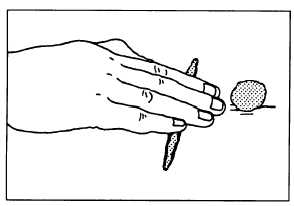The typical reactions that are obtained in this test
for various types of soils are described below.
1. Very highly plastic soils (CH). The pat cannot be
broken or powdered by finger pressure.
2. Highly plastic soils (CH). The pat can be broken
with great effort, but cannot be powdered.
3. Medium plastic soils (CL). The pat can be
broken and powdered with some effort.
4. Slightly plastic soils (ML, MH, or CL). The pat
can be broken quite easily and powdered readily.
5. Nonplastic soils (ML, MH, OL, or OH). The pat
has little or no dry strength and crumbles or powders
when picked up.
ROLL OR THREAD TEST
This test is performed only on the material passing
a No. 40 sieve. First, you mix a representative portion
of the sample with water until it can be molded or shaped
without sticking to your fingers. This moisture content
is referred to as being just below the sticky limit.
Next, prepare a nonabsorbent rolling surface by
placing a sheet of glass or heavy wax paper on a flat
or level support. Place the sample on this surface and
shape it into an elongated cylindrical shape. Then
attempt to roll the cylindrical sample rapidly into a
thread approximately 1/8 inch in diameter (fig. 16-6).
If the moist soil rolls into a thread, it has some
plasticity. The number of times it can be rolled into a
thread without crumbling is a measure of the degree
of plasticity of the soil. Materials that cannot be rolled
in this manner are nonplastic or have extremely low
plasticity.
Figure 16-6.-Roll or thread test.
The results of this test indicate the following:
1. High plasticity (CH). The soil can be molded
into a ball or cylinder and deformed under firm finger
pressure without crumbling or cracking.
2. Medium plasticity (CL). The soil can be molded,
but it cracks or crumbles under finger pressure.
3. Low plasticity (CL, ML, or MH). The soil
cannot be lumped into a ball or cylinder without
breaking up.
4. Organic material (OL or OH). The soil forms a
soft, spongy ball or thread when molded.
5. Nonplastic soil (ML or MH). The soil cannot be
rolled into a thread at any moisture content.
From the thread test, the cohesiveness of the
material near the plastic limit may also be described as
weak, firm, or tough. The higher the soil is on the
plasticity chart, the stiffer the threads are as they dry out
and the tougher the lumps are if the soil is remolded after
rolling.
RIBBON TEST
The ribbon test is performed only on the material
passing the No. 40 sieve. The sample prepared for use
in this test should have a moisture content that is slightly
below the sticky limit. Using this material, form a roll
of soil about 1/2 to 3/4 inch in diameter and about 3 to
5 inches long. Place this material in the palm of your
hand and, starting at one end, flatten the roll, forming a
ribbon 1/8 to 1/4 inch thick. This is done by squeezing
it between your thumb and forefinger (fig. 16-7).
Handle the sample carefully to form the maximum
length of ribbon that can be supported by the cohesive
properties of the material. If the soil sample holds
together for a length of 6 to 10 inches without breaking,
the material is then considered to be both highly plastic
and highly compressive (CH). If the soil cannot be
ribboned, it is nonplastic (ML or MH). If it can be
ribboned, it is nonplastic (ML or MH). If it can be
ribboned only with difficulty into short lengths, the soil
is considered to have low plasticity (CL). The roll test
and the ribbon test complement each other in giving a
clearer picture of the degree of plasticity of soil.
WET-SHAKING TEST
The wet-shaking test is performed only on the
material passing the No. 40 sieve. In the preparation of
a portion of the sample for use in this test, enough
material to form a ball of material about 3/4 inch in
16-18


